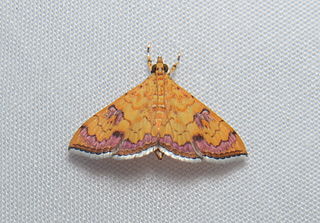Related Research Articles

Isocentris is a genus of moths of the family Crambidae described by Edward Meyrick in 1887.

Rivula is a genus of moths in the family Erebidae described by Achille Guenée in 1845.
Stracena is a genus of moths in the subfamily Lymantriinae. The genus was erected by Charles Swinhoe in 1903.
Digama africana is a moth of the family Erebidae first described by Charles Swinhoe in 1907. It is found in Eritrea, Kenya and Tanzania.
Digama costimacula is a moth of the family Erebidae first described by Charles Swinhoe in 1907. It is found in Ghana, Kenya and Nigeria.
Digama lithosioides is a moth of the family Erebidae first described by Charles Swinhoe in 1907. It is found in Ethiopia, Tanzania and Zimbabwe.
Digama meridionalis is a moth of the family Erebidae first described by Charles Swinhoe in 1907. It is found in much of southern and eastern Africa.
Scopula cassiaria is a moth of the family Geometridae first described by Charles Swinhoe in 1904. It is found in Kenya and Uganda.

Isocentris filalis is a moth of the family Crambidae described by Achille Guenée in 1854. It is found in Cameroon, Comoros, the Democratic Republic of the Congo, Réunion, Madagascar, Mauritius, Togo Indonesia (Java) and Taiwan.
Chloroclystis sierraria is a moth in the family Geometridae. It was described by Charles Swinhoe in 1904. It is found in Sierra Leone, Yemen and Angola.
Heterorachis asyllaria is a species of moth of the family Geometridae first described by Charles Swinhoe in 1904. It is found on Madagascar.
Comibaena punctaria is a moth of the family Geometridae first described by Charles Swinhoe in 1904. It is found on Madagascar.
Cyclophora sublunata is a moth in the family Geometridae first described by Charles Swinhoe in 1904. It is found in Ghana and Ivory Coast.

Eublemma acarodes is a species of moth of the family Erebidae first described by Charles Swinhoe in 1907. It is found in Angola, Madagascar, Tanzania and Zimbabwe.
Galtara elongata is a moth of the subfamily Arctiinae. It was described by Charles Swinhoe in 1907. It is found in the Democratic Republic of the Congo, Ethiopia, Kenya and Rwanda.
Xylecata rattrayi is a moth of the family Erebidae first described by Charles Swinhoe in 1904. It is found in Angola, Cameroon, the Democratic Republic of the Congo, Kenya, Tanzania and Uganda.
Ptychopseustis ictericalis is a moth in the family Crambidae first described by Charles Swinhoe in 1886. It is found in India and Saudi Arabia.
Hyalobathra barnsalis is a moth in the family Crambidae. It was described by Pierre Viette in 1957. Its type locality is Bombaim. It is found on the island of São Tomé in São Tomé and Príncipe.
Isocentris seychellalis is a moth in the family Crambidae. It was described by Thomas Bainbrigge Fletcher in 1910. It is found on the Seychelles.

Autocharis fessalis is a moth in the family Crambidae. It was described by Charles Swinhoe in 1886. It is found in the Democratic Republic of the Congo, on the Seychelles and in South Africa, the United Arab Emirates, Yemen, Bhutan, India and Pakistan.
References
- ↑ Nuss, M.; et al. (2003–2014). "GlobIZ search". Global Information System on Pyraloidea. Retrieved 15 July 2014.
- ↑ De Prins, J. & De Prins, W. (2019). "Isocentris charopalis Swinhoe, 1907". Afromoths. Retrieved 20 April 2020.
- ↑ Herbison-Evans, Don & Crossley, Stella (12 April 2019). "Isocentris charopalis Swinhoe, 1907". Australian Caterpillars and their Butterflies and Moths. Retrieved 20 April 2020.
| This Pyraustinae-related article is a stub. You can help Wikipedia by expanding it. |